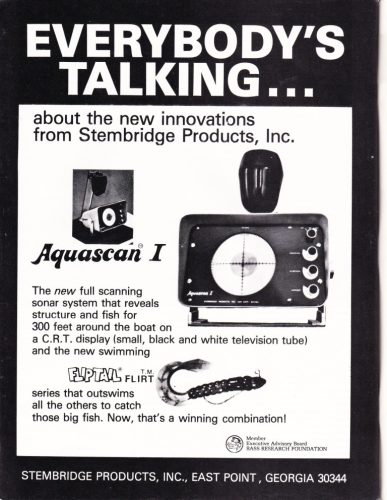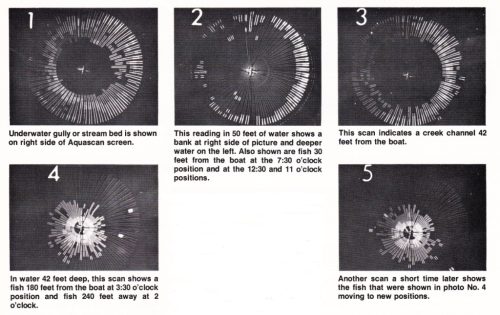Throwback Thursday – Before There was 360-Imaging
By Terry Battisti – Bass Fishing Archives
As with many of the articles we post here on the Bass Fishing Archives, here’s another example of something new that really isn’t new. Before there was 360-Imaging, there was, in 1976, 360-imaging. Believe it or not.
When side-scanning sonar was “reintroduced” around 2005 by Hummingbird, the angling community again was split down the middle. As with other technological advances, some anglers said it was too much and made the art of fishing too easy. The other half embraced the technology and ran with it. Then came Hummingbird’s 360-Imaging. Now, as with any other gadget used in the industry, anglers far and wide realize the utility of side-scanning sonar but more so, they realize that these units aren’t going to make the task of catching fish any easier.

So when did 360-imaging and side-scanning sonar really come out? Well, if you look back in history it was developed in the late 40s and early 50s and was used by the Department of Defense to detect ocean-borne mines. The first functioning side-scanning sonar was developed by a German scientist by the name of Dr. Julius Hagemann while working for the U.S. Navy Mine Defense Lab in Florida. His 1954 patent went unknown to the public until 1980 when the classified project was finally released.
The interesting thing about the above paragraph is in 1976 – four years prior to the release of the classified reports – Bill Stembridge (of Flip Tail Lure fame) and Dr. Roger Woodward, developed a unit called the Aquascan, which featured the ability to see under the water in a 360-degree pattern. What I find interesting with this is if the DoD’s use of side-scan was classified, Stembridge and Woodward must have come up with the thought of this technology on their own or, heaven forbid, someone in the DoD leaked the information to a couple of fishermen who then took the technology and developed it for use in fishing.

Reading through the article in the February 1976 issue of Bassmaster Magazine, I found some interesting details about the Aquascan and thought I’d share them with you. “It can show bottom structure and fair-sized fish up to 300 feet away from the boat.” “The Unit consists of three basic parts. The transducer sends out sonar signals and receives echoes. The computer interprets the echoes and transforms them into ‘pictures’ of the objects scanned. The cathode ray tube (CRT) displays the picture.” “On a 300-foot scan, the device covers 6-3/4 acres of water per scan.”
“Bill Stembridge admits that the Aquascan has its limitations. It will not tell you exactly where a fish is located. It will show the fish to be, for example, 40 feet away at a given direction from the boat. The angler does not know if the fish is at the surface 40 feet away or several feet below the surface and much closer to the boat.”

“Aquascan will show you a 12-inch bass at 300 feet if the fish is broadside to the scan. If it is facing head-on, a larger bass can be missed.” Looking at the “images” – I hate to call them images because they aren’t true images but more like a circular line graphs – in this article, it’s safe to say it would take a lot of experience with the unit to make it of value in a bass boat. Not only that, the unit was quite large (larger than today’s side-scanning units) and difficult to place on the boats of the day.
The biggest drawback of the unit was the cost, though. At $1,000 (that’s equivalent to roughly $4,800 today) not many anglers could afford them. Today, though, it seems anglers are willing to go the extra mile when it comes to outfitting their boats with high-end electronics. Believe it or not, today’s incredible 360-Imaging by Humminbird as well as Sidescan, Downscan and forward-facing real-time imaging from all manufacturers are all byproducts of this early technology. The difference today being anglers are a lot more willing to spend more than $10k on electronics to aid in their pursuit of bass.

















